Recognizing phishing emails like "Pending Messages On Our Remote Server"
Phishing/ScamAlso Known As: "Pending Messages On Our Remote Server" phishing email
Get free scan and check if your device is infected.
Remove it nowTo use full-featured product, you have to purchase a license for Combo Cleaner. Seven days free trial available. Combo Cleaner is owned and operated by RCS LT, the parent company of PCRisk.com.
What kind of email is "Pending Messages On Our Remote Server"?
Our inspection of the "Pending Messages On Our Remote Server" email revealed that it operates as a phishing scam. This letter seeks to obtain the recipient's email account log-in credentials by making false claims about messages failing to reach their inbox.
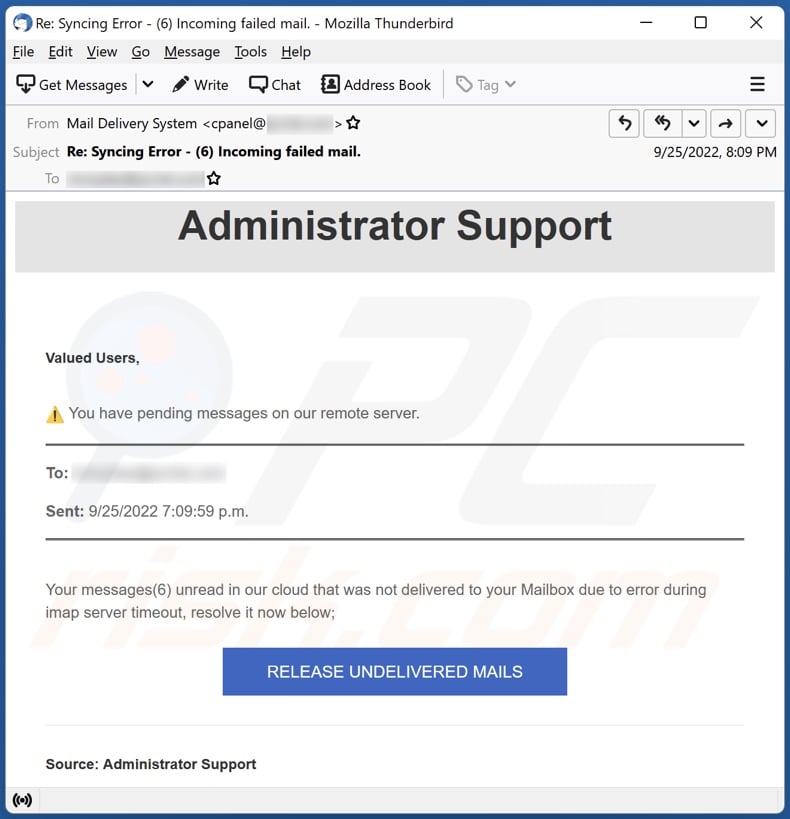
"Pending Messages On Our Remote Server" email scam overview
The spam email with the subject "Syncing Error - (6) Incoming failed mail." (may vary) informs the recipient that there are messages pending on their email provider's server. The letter clarified that due to a server timeout an inbox error occurred, which prevented six messages from reaching the recipient.
The scam email instructs to press the "RELEASE UNDELIVERED MAILS" button to retrieve the pending messages. When we clicked this button, it resulted in a redirect to a phishing site. The webpage was presented as an email account sign-in page. The visitor was requested to log in with their email account - thus providing the necessary authentication.
By believing this fake email and attempting to sign in through the phishing website - users will unintentionally expose their email accounts. Furthermore, cyber criminals may also steal the content registered through the email.
To expand on how they can abuse this unauthorized access, the criminals may use hijacked communication accounts (e.g., emails, messengers, social networking/media, etc.) to proliferate malware by sharing malicious files or links. The scammers can also assume the victim's identity and ask their contacts/friends/followers for loans or donations.
Finance-related accounts (e.g., online banking, money transferring, e-commerce, digital wallets, etc.) can be used to perform unauthorized transactions and/or online purchases.
In summary, by falling for a spam email like "Pending Messages On Our Remote Server" - victims can experience system infections, severe privacy issues, financial losses, and identity theft.
If you have already disclosed your log-in credentials - we strongly advise you to immediately change the passwords of all potentially compromised accounts and contact their official support.
| Name | "Pending Messages On Our Remote Server" phishing email |
| Threat Type | Phishing, Scam, Social Engineering, Fraud |
| Fake Claim | Emails failed to reach the recipient's inbox due to an error. |
| Symptoms | Unauthorized online purchases, changed online account passwords, identity theft, illegal access of the computer. |
| Distribution methods | Deceptive emails, rogue online pop-up ads, search engine poisoning techniques, misspelled domains. |
| Damage | Loss of sensitive private information, monetary loss, identity theft. |
| Malware Removal (Windows) |
To eliminate possible malware infections, scan your computer with legitimate antivirus software. Our security researchers recommend using Combo Cleaner. Download Combo CleanerTo use full-featured product, you have to purchase a license for Combo Cleaner. 7 days free trial available. Combo Cleaner is owned and operated by RCS LT, the parent company of PCRisk.com. |
Phishing spam campaign examples
"Your PayPal Account Is Temporarily Limited", "Blocked (Important) Incoming Messages", "Request To Terminate/Disable Your Email", "Password Is Scheduled To Expire" - are just some examples of phishing emails that we have inspected recently.
These letters can wear a wide variety of disguises and make different claims. They can be presented as messages from legitimate companies, service providers, organizations, authorities, and other entities. However, spam emails are not used just to facilitate scams, they can also distribute malware (e.g., trojans, ransomware, cryptominers, etc.).
How do spam campaigns infect computers?
Malicious files are distributed through spam mail as attachments or download links. These files can be in various formats, e.g., executables (.exe, .run, etc.), archives (ZIP, RAR, etc.), Microsoft Office and PDF documents, JavaScript, and so forth.
Once a virulent file is executed, run, or otherwise opened - malware download/installation processes are triggered. For example, Microsoft Office documents infect devices by executing malicious macro commands.
How to avoid installation of malware?
We highly recommend being careful with incoming emails, PMs/DMs, SMSes, and other messages. The attachments and links found in dubious/irrelevant mail must not be opened, as they can be malicious and cause infections.
We advise using post-2010 Microsoft Office versions since they have the "Protected View" mode that prevents automatic macro execution.
However, malware is not spread exclusively via spam mail. Hence, we also recommend downloading only from official/verified sources and activating/updating programs with legitimate tools (illegal activation tools ["cracks"] and third-party updates may contain malware).
Another recommendation is to exercise caution when browsing since fraudulent and dangerous content usually appears genuine and innocuous.
We must stress the importance of having a reputable anti-virus installed and kept updated. Security software must be used to run regular system scans and to remove threats and issues. If you've already opened malicious attachments, we recommend running a scan with Combo Cleaner Antivirus for Windows to automatically eliminate infiltrated malware.
Text presented in the "Pending Messages On Our Remote Server" email letter:
Subject: Re: Syncing Error - (6) Incoming failed mail.
Administrator Support
Valued Users,
You have pending messages on our remote server.
To: -
Sent: 9/25/2022 7:09:59 p.m.
Your messages(6) unread in our cloud that was not delivered to your Mailbox due to error during imap server timeout, resolve it now below;
RELEASE UNDELIVERED MAILS
Source: Administrator Support
Screenshot of the phishing website promoted by the "Pending Messages On Our Remote Server" spam campaign:
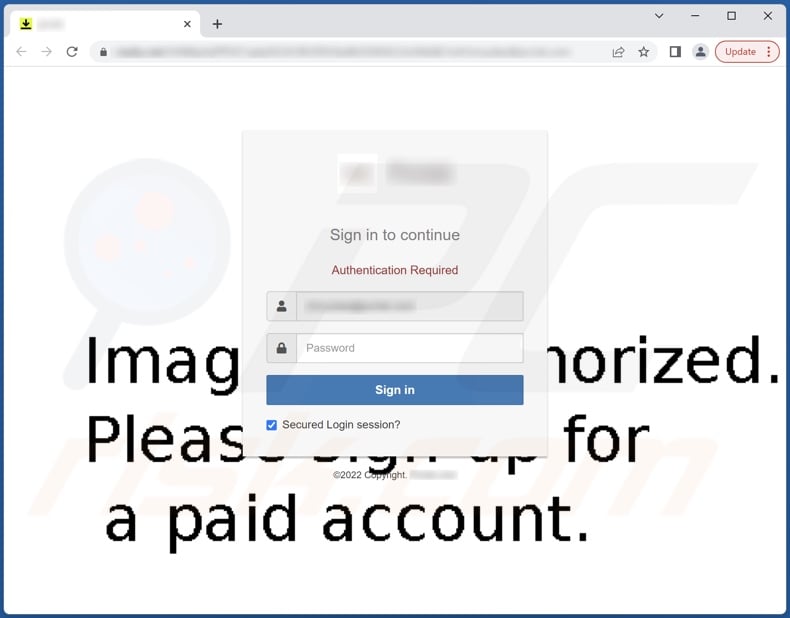
Another example of pending emails-themed spam promoting a phishing site:
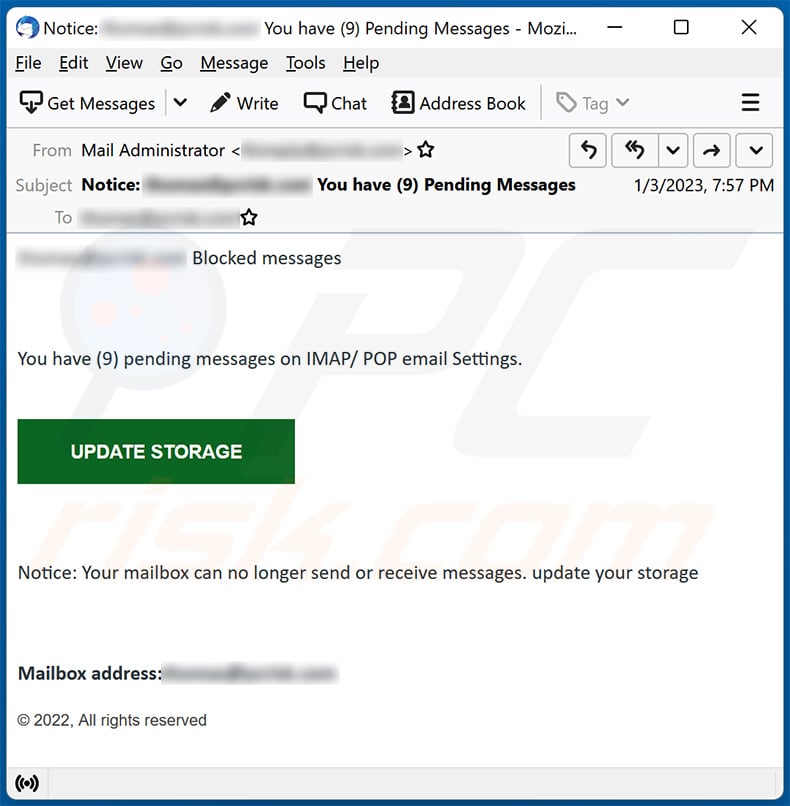
Text presented within:
Subject: Notice: ********* You have (9) Pending Messages
********* Blocked messages
You have (9) pending messages on IMAP/ POP email Settings.
UPDATE STORAGE
Notice: Your mailbox can no longer send or receive messages. update your storage
Mailbox address:*********© 2022, All rights reserved
Another example of a pending email messages-themed spam promoting a phishing site:
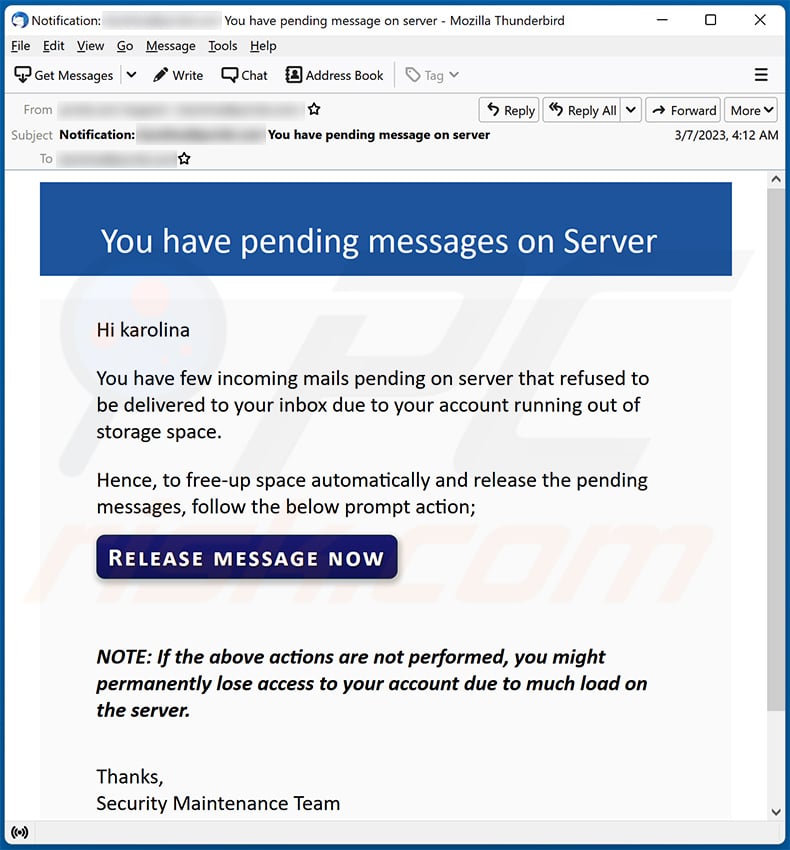
Text presented within:
Subject: Notification: - You have pending message on server
You have pending messages on ServerHi karolina
You have few incoming mails pending on server that refused to be delivered to your inbox due to your account running out of storage space.
Hence, to free-up space automatically and release the pending messages, follow the below prompt action;
NOTE: If the above actions are not performed, you might permanently lose access to your account due to much load on the server.
Thanks,
Security Maintenance TeamThis notification was sent automatically from server to -
Another example of pending email-themed spam:
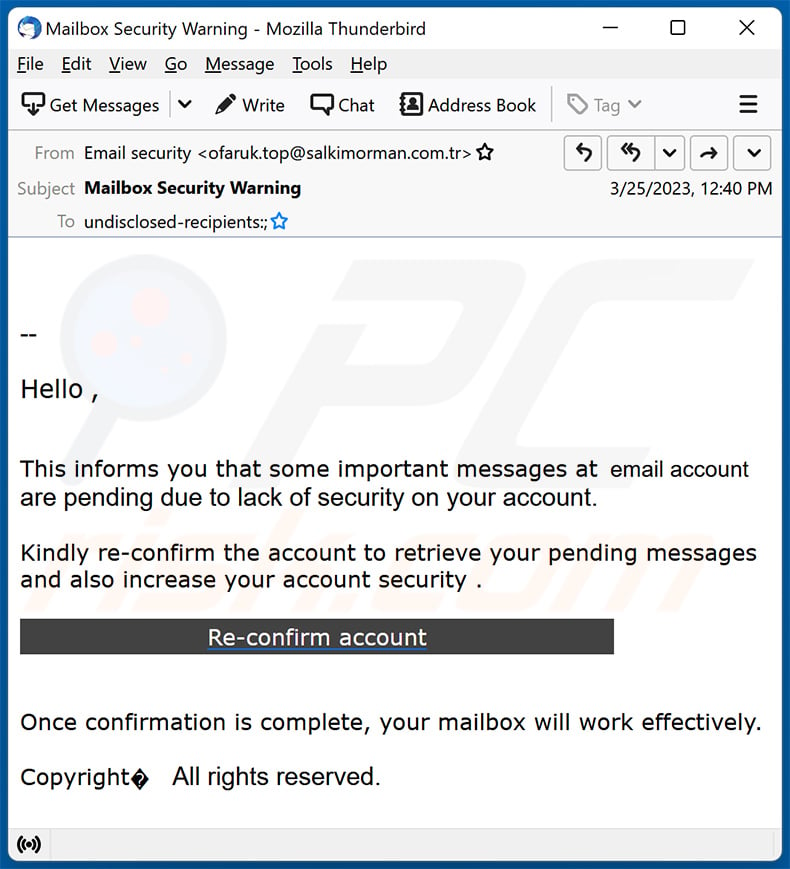
Text presented within:
Subject: Mailbox Security Warning
Hello ,
This informs you that some important messages at email account are pending due to lack of security on your account.Kindly re-confirm the account to retrieve your pending messages and also increase your account security .
Re-confirm account
Once confirmation is complete, your mailbox will work effectively.Copyright All rights reserved.
Yet another example of an email from "pending messages" spam campaign:
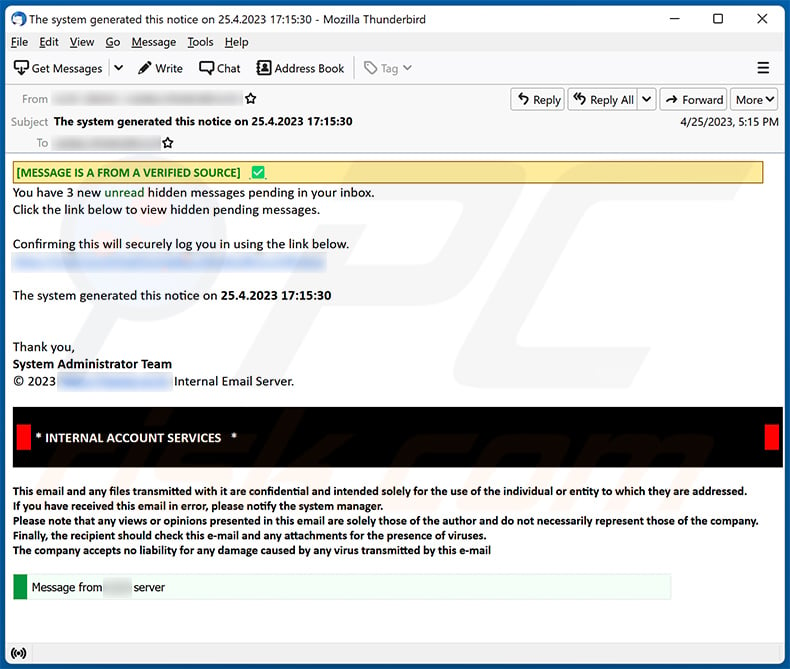
Text presented within:
Subject: The system generated this notice on 25.4.2023 17:15:30
[MESSAGE IS A FROM A VERIFIED SOURCE]You have 3 new unread hidden messages pending in your inbox.
Click the link below to view hidden pending messages.Confirming this will securely log you in using the link below.
-
The system generated this notice on 25.4.2023 17:15:30Thank you,
System Administrator Team
© 2023 -. Internal Email Server.* INTERNAL ACCOUNT SERVICES *
Screenshot of the promoted phishing site:
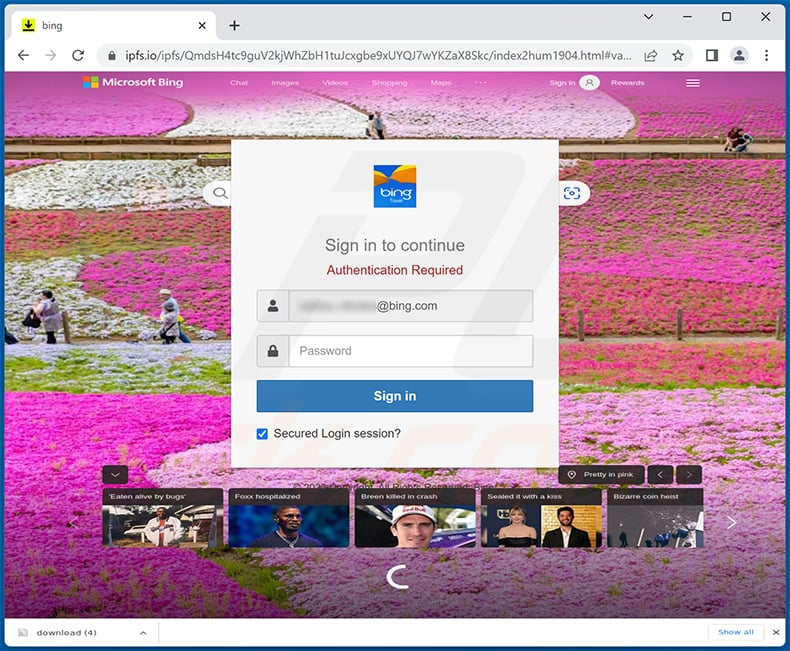
A Spanish variant of "Pending Messages On Our Remote Server" scam email:
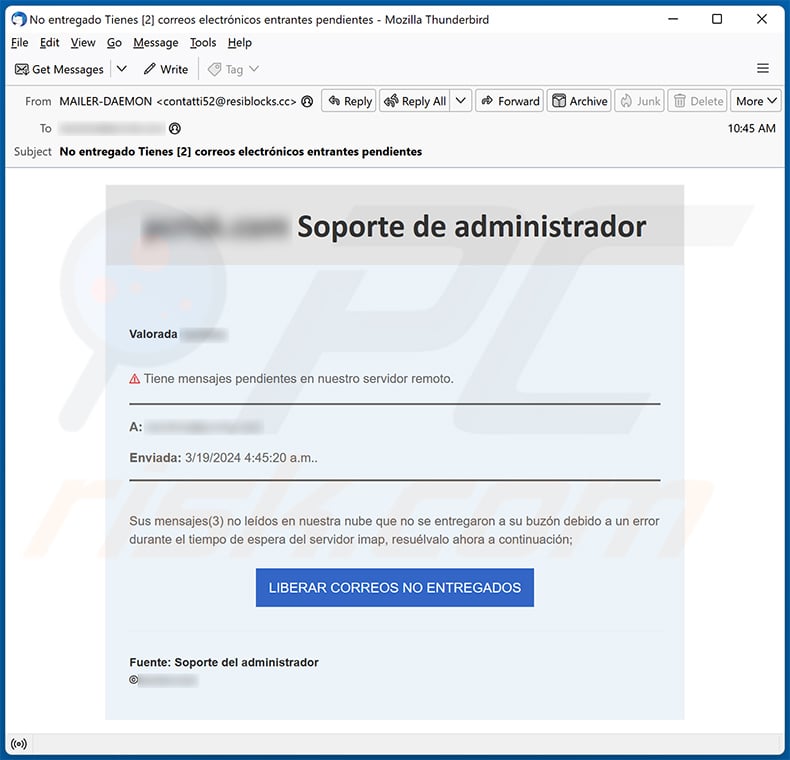
Text presented within:
Subject: No entregado Tienes [2] correos electrónicos entrantes pendientes
******** Soporte de administrador
Valorada ********,Tiene mensajes pendientes en nuestro servidor remoto.
A: ********
Enviada: 3/19/2024 4:45:20 a.m..
Sus mensajes(3) no leídos en nuestra nube que no se entregaron a su buzón debido a un error durante el tiempo de espera del servidor imap, resuélvalo ahora a continuación;LIBERAR CORREOS NO ENTREGADOS
Fuente: Soporte del administrador
©********
Instant automatic malware removal:
Manual threat removal might be a lengthy and complicated process that requires advanced IT skills. Combo Cleaner is a professional automatic malware removal tool that is recommended to get rid of malware. Download it by clicking the button below:
DOWNLOAD Combo CleanerBy downloading any software listed on this website you agree to our Privacy Policy and Terms of Use. To use full-featured product, you have to purchase a license for Combo Cleaner. 7 days free trial available. Combo Cleaner is owned and operated by RCS LT, the parent company of PCRisk.com.
Quick menu:
- What is "Pending Messages On Our Remote Server" phishing email?
- Types of malicious emails.
- How to spot a malicious email?
- What to do if you fell for an email scam?
Types of malicious emails:
![]() Phishing Emails
Phishing Emails
Most commonly, cybercriminals use deceptive emails to trick Internet users into giving away their sensitive private information, for example, login information for various online services, email accounts, or online banking information.
Such attacks are called phishing. In a phishing attack, cybercriminals usually send an email message with some popular service logo (for example, Microsoft, DHL, Amazon, Netflix), create urgency (wrong shipping address, expired password, etc.), and place a link which they hope their potential victims will click on.
After clicking the link presented in such email message, victims are redirected to a fake website that looks identical or extremely similar to the original one. Victims are then asked to enter their password, credit card details, or some other information that gets stolen by cybercriminals.
![]() Emails with Malicious Attachments
Emails with Malicious Attachments
Another popular attack vector is email spam with malicious attachments that infect users' computers with malware. Malicious attachments usually carry trojans that are capable of stealing passwords, banking information, and other sensitive information.
In such attacks, cybercriminals' main goal is to trick their potential victims into opening an infected email attachment. To achieve this goal, email messages usually talk about recently received invoices, faxes, or voice messages.
If a potential victim falls for the lure and opens the attachment, their computers get infected, and cybercriminals can collect a lot of sensitive information.
While it's a more complicated method to steal personal information (spam filters and antivirus programs usually detect such attempts), if successful, cybercriminals can get a much wider array of data and can collect information for a long period of time.
![]() Sextortion Emails
Sextortion Emails
This is a type of phishing. In this case, users receive an email claiming that a cybercriminal could access the webcam of the potential victim and has a video recording of one's masturbation.
To get rid of the video, victims are asked to pay a ransom (usually using Bitcoin or another cryptocurrency). Nevertheless, all of these claims are false - users who receive such emails should ignore and delete them.
How to spot a malicious email?
While cyber criminals try to make their lure emails look trustworthy, here are some things that you should look for when trying to spot a phishing email:
- Check the sender's ("from") email address: Hover your mouse over the "from" address and check if it's legitimate. For example, if you received an email from Microsoft, be sure to check if the email address is @microsoft.com and not something suspicious like @m1crosoft.com, @microsfot.com, @account-security-noreply.com, etc.
- Check for generic greetings: If the greeting in the email is "Dear user", "Dear @youremail.com", "Dear valued customer", this should raise suspiciousness. Most commonly, companies call you by your name. Lack of this information could signal a phishing attempt.
- Check the links in the email: Hover your mouse over the link presented in the email, if the link that appears seems suspicious, don't click it. For example, if you received an email from Microsoft and the link in the email shows that it will go to firebasestorage.googleapis.com/v0... you shouldn't trust it. It's best not to click any links in the emails but to visit the company website that sent you the email in the first place.
- Don't blindly trust email attachments: Most commonly, legitimate companies will ask you to log in to their website and to view any documents there; if you received an email with an attachment, it's a good idea to scan it with an antivirus application. Infected email attachments are a common attack vector used by cybercriminals.
To minimise the risk of opening phishing and malicious emails we recommend using Combo Cleaner Antivirus for Windows.
Example of a spam email:

What to do if you fell for an email scam?
- If you clicked on a link in a phishing email and entered your password - be sure to change your password as soon as possible. Usually, cybercriminals collect stolen credentials and then sell them to other groups that use them for malicious purposes. If you change your password in a timely manner, there's a chance that criminals won't have enough time to do any damage.
- If you entered your credit card information - contact your bank as soon as possible and explain the situation. There's a good chance that you will need to cancel your compromised credit card and get a new one.
- If you see any signs of identity theft - you should immediately contact the Federal Trade Commission. This institution will collect information about your situation and create a personal recovery plan.
- If you opened a malicious attachment - your computer is probably infected, you should scan it with a reputable antivirus application. For this purpose, we recommend using Combo Cleaner Antivirus for Windows.
- Help other Internet users - report phishing emails to Anti-Phishing Working Group, FBI’s Internet Crime Complaint Center, National Fraud Information Center and U.S. Department of Justice.
Frequently Asked Questions (FAQ)
Why did I receive this email?
Spam emails are not personal. They are distributed in large-scale campaigns - therefore, thousands of users receive identical scam messages.
I have provided my personal information when tricked by this spam email, what should I do?
If you have disclosed account credentials - change the passwords of all possibly exposed accounts and inform their official support without delay. And if you've provided other private data (e.g., ID card details, credit card numbers, etc.) - immediately contact the appropriate authorities.
I have read a spam email but didn't open the attachment, is my computer infected?
No, opening/reading an email will not result in a system infection. Malware download/installation chains are initiated when the attachments or links found in spam mail are opened/clicked.
I have downloaded and opened a file attached to a spam email, is my computer infected?
Whether an infection occurred may depend on the opened file's format. Once opened, executables (.exe, .run, etc.) infect devices almost without fail. On the other hand, document formats (.doc, .xls, .pdf, etc.) may require additional actions (e.g., enabling macro commands) to begin downloading/installing malware.
Will Combo Cleaner remove malware infections present in email attachments?
Yes, Combo Cleaner is designed to detect and remove threats. It can eliminate most of the known malware infections. However, it must be emphasized that since sophisticated malicious software usually hides deep within systems - running a complete system scan is essential for its detection.
Share:

Tomas Meskauskas
Expert security researcher, professional malware analyst
I am passionate about computer security and technology. I have an experience of over 10 years working in various companies related to computer technical issue solving and Internet security. I have been working as an author and editor for pcrisk.com since 2010. Follow me on Twitter and LinkedIn to stay informed about the latest online security threats.
PCrisk security portal is brought by a company RCS LT.
Joined forces of security researchers help educate computer users about the latest online security threats. More information about the company RCS LT.
Our malware removal guides are free. However, if you want to support us you can send us a donation.
DonatePCrisk security portal is brought by a company RCS LT.
Joined forces of security researchers help educate computer users about the latest online security threats. More information about the company RCS LT.
Our malware removal guides are free. However, if you want to support us you can send us a donation.
Donate
▼ Show Discussion